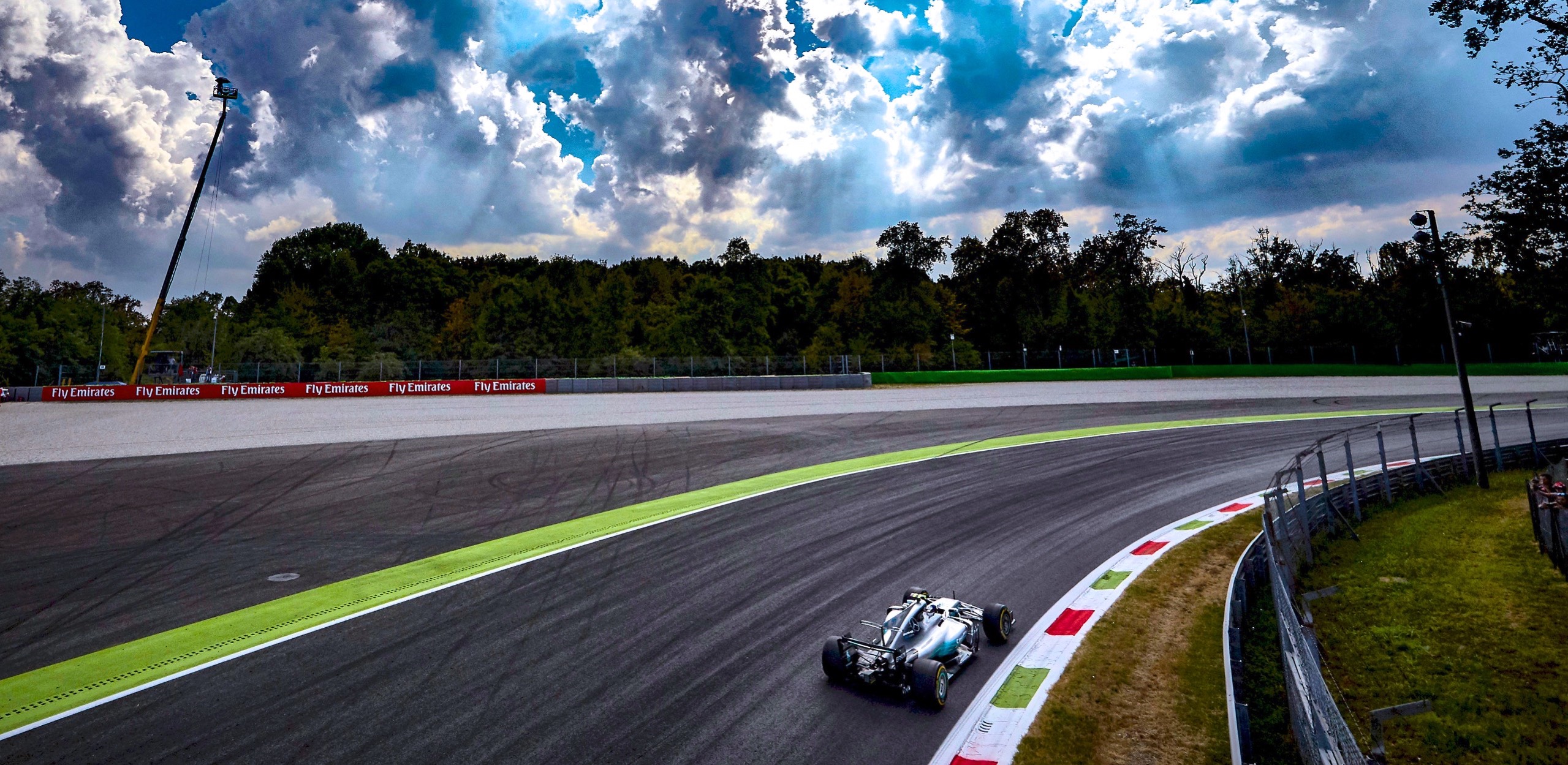
Lewis Hamilton dominated the 2017 Italian Grand Prix, taking his record breaking 69th pole during a dramatically wet qualifying session, and then cruising virtually unopposed in beautiful sunshine to his 6th victory this season ahead of teammate Valtteri Bottas, giving Mercedes their second one-two of the year. His win gave him the outright lead over third place finisher Sebastian Vettel in the World Drivers Championship for the first time this season.
Daniel Ricciardo set the Monza circuit on fire as he put in one blistering lap after another throughout the race to bring his Red Bull from 16th to fourth, even flirting with catching Vettel over the final ten laps.

Monza exudes the heart and soul of Formula One racing. As the third permanent race track in existence after Brooklands in the UK and Indianapolis in the USA, it premiered in 1922 as a banked 10-kilometre basilica of speed, built among the grand old trees in the royal park. Formula One racing visited the circuit as part of the inaugural season in 1950, and it has remained a permanent fixture on the calendar ever since.
The banking was retired since 1961, but Monza remains stunningly fast, subtly nuanced and stubbornly fatal to both good and great. Reading the names of those who have either won here or perished here is a very emotional experience for learned racing fans, but especially for the “tifosi”, the spirited Italian racing devotees immersed under the spell of ‘La Pista Magica’, the magic track.
In the early 1950s and forward, Monza was a slipstreaming contest where cars raced nose-to-tail using the draft of other competitors cars to slingshot past. Now, with aerodynamic advancements, new rules and chicanes, those contests have passed on, but what the 11 turn track has lost in close wheel-to-wheel racing, it has gained in the outright staggering speeds of the wider and grippier 2017 cars that produce laps that average more than 150 mph.
Monza represents the ultimate balancing of low drag to downforce over a lap of 5.793 kilometres. Too little downforce and you’ll have no tire temperature and thus no grip in mid-corner Parabolica; to much drag and you’ll see trailing competition whistle past you halfway down the front straight. Should you have that imbalance in a wet Grands Prix, you’ll face heart-stopping moments ten times a lap for 53 laps. Get it right, and you’ll stand on the podium, above 30,000 jubilant tifosi.
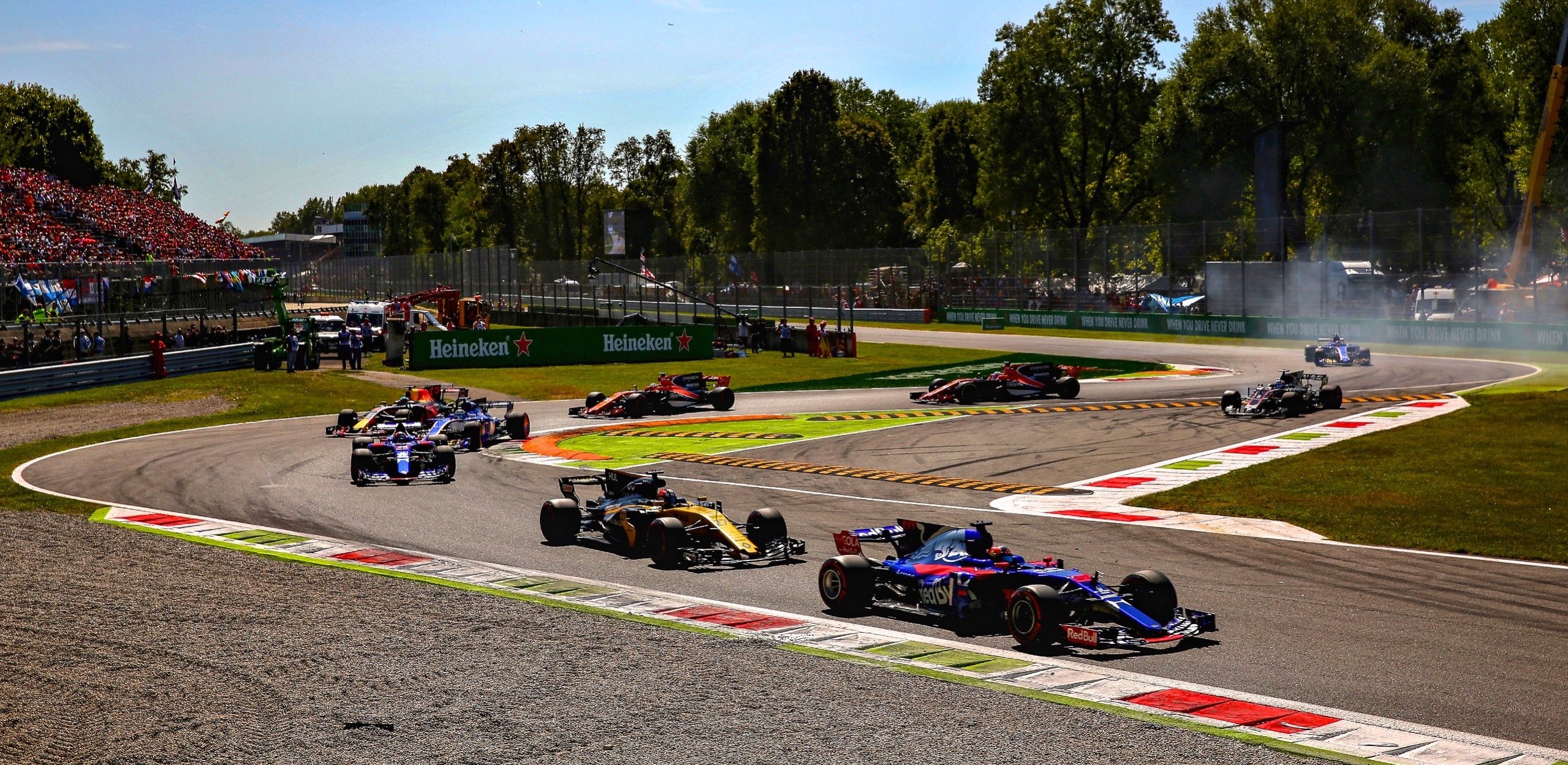
Monza’s Saturday’s qualifying drama will be remembered long after Sunday’s Grand Prix. The intermittent torrential rains and heavy spray produced a spectacle of almost unimaginable chance; any driver might be able to take the pole. It seemed every 30-seconds a new and sometimes unexpected name would head the Q1-Q2 and finally Q3 timesheet. Added to that pure drama were the draconian engine-change grid penalties already announced for both Red Bull and McLaren team drivers.
While Lewis Hamilton used his 201st Grand Prix to win his 69th and record-breaking pole, it was rookie Lance Stroll who provided the shock, as he and Esteban Ocon would start second and third on the grid, after engine penalties for Max Verstappen and Daniel Ricciardo. Stroll has never had any wet tyre testing, but to be sure his Williams team will do the Happy Rain Dance for him the remainder of the season. He becomes the youngest driver to sit on the front row of a Grand Prix race in history.
“You set up the car to go as fast as you can, and the classic rain set-ups don’t exist anymore.”
Sebastian Vettel
Another surprise was Ferrari’s sudden drop in competitiveness in Q3. While the Scuderia was close to the Mercedes duo in Q1-Q2, they finished a dismal 2.5-seconds on full wets behind pole man Hamilton. Was it that Ferrari had some secret dry weather setup that hobbled them in the rain, but would come amazingly right on the expected dry race day?
 No, explained Vettel in media briefs.”You set up the car to go as fast as you can, and the classic rain set-ups don’t exist anymore,” he said.”I doubt if anyone set up the car for the wet today.”
No, explained Vettel in media briefs.”You set up the car to go as fast as you can, and the classic rain set-ups don’t exist anymore,” he said.”I doubt if anyone set up the car for the wet today.”
At Monza, cars traditionally need low drag to produce the highest speeds, yet the Curve Grande and Lesmos sections need plenty of downforce, as does the heart-stopping opening radius high-speed exit out of the Parabolica. Also twisting the expectations was the fact that both Red Bulls had the highest measured straight-line speeds and they still qualified 2-3 before they received FIA race day starting grid penalties for power unit replacements.
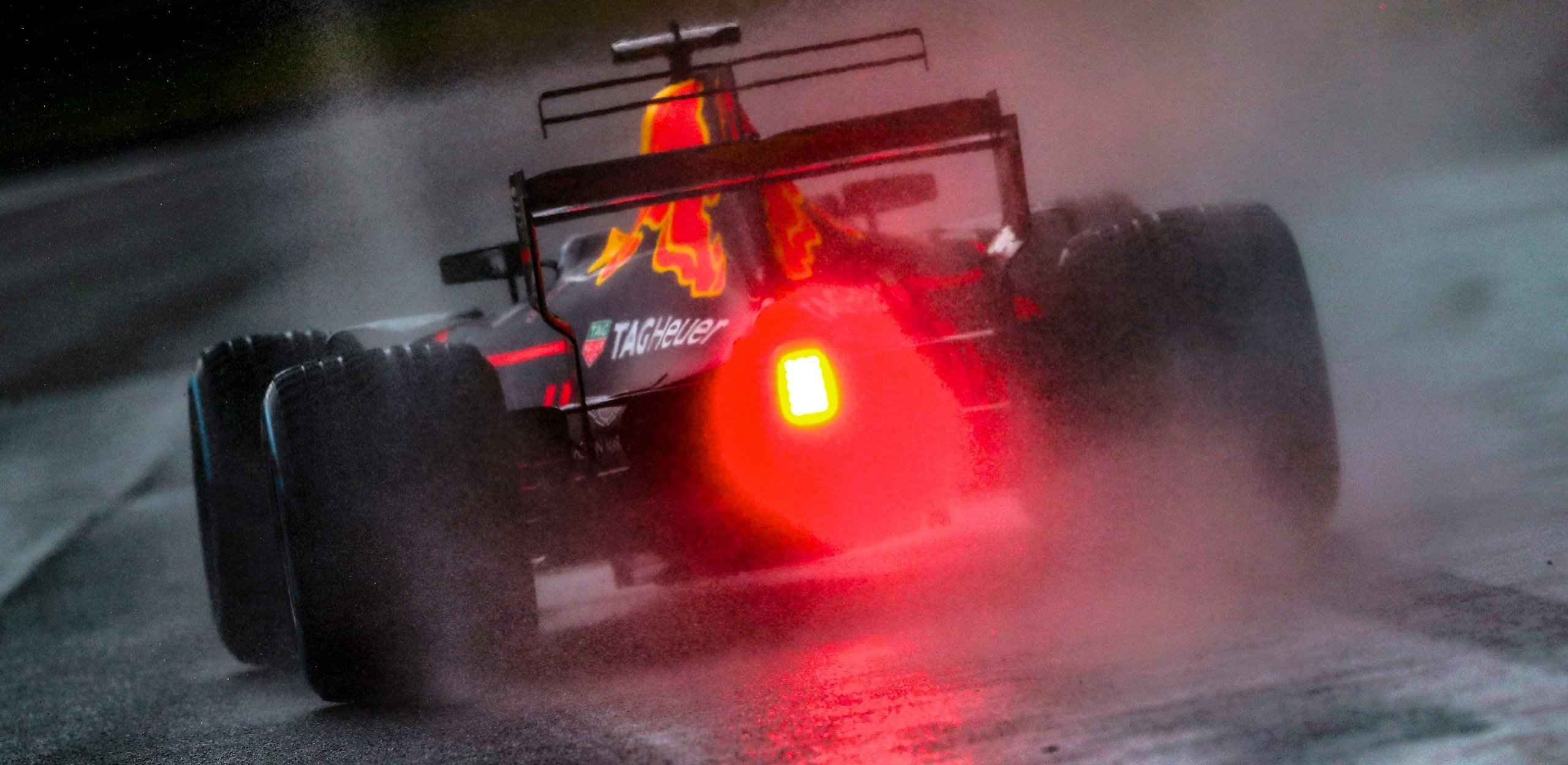
Hamilton made a great start and immediately moved right across the track to hold off from Lance Stroll approaching Turn 1. Stroll reacted by easing back from Hamilton’s tail opening the door for Esteban Ocon. Having starting third, Ocon stayed on the outside line and swept around Stroll to grab second. Valtteri Bottas was already on the charge from his fourth starting position, bashing wheels with frequent sparring mate Kimi Raikkonen as they came through the Turn 1 chicane to move into fourth. Raikkonen returned the favour when he passed inside Bottas at the second chicane to regain the position, but Bottas was determined, re-passing Raikkonen around the outside of the Parabolica to solidify his forward advance. Bottas then moved up to third as he passed Stroll on Lap 3 and then finally whistling past Ocon on Lap 4 to settle into second place and take up a rear guard position for the rapidly disappearing Hamilton.
By lap 10, Raikkonen had fallen back to sixth as team-mate Vettel methodically moved past him, Stroll and Ocon to claim third.
On Lap 3, Felipe Massa dive-bombed Max Verstappen in Turn 2 leaving the Dutchman with a punctured front tyre and a damaged wheel. Verstappen’s slow return to his pit dropped him to last, but the determined teenager recovered to get the final point by finishing 10th.
Raikkonen sat in the wake of Ocon and Stroll until lap 16 when he suffered a slow pit stop for softs, returning in 11th. Ocon pitted to cover a lap later and returned six seconds ahead of Raikkonen. A lap later Stroll was in for softs, but this time Williams was delayed in releasing Stroll, and he rejoined behind Ocon and Raikkonen. By now, Ricciardo had moved up to 5th.
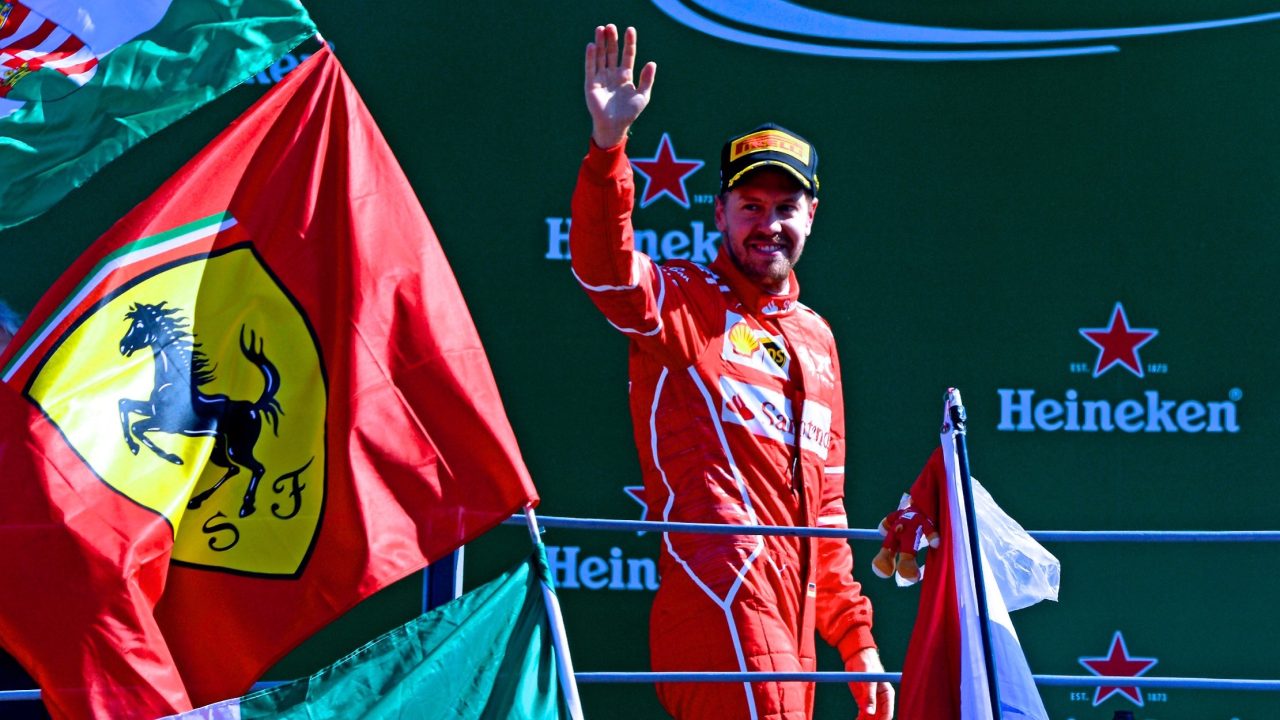 Ocon lost 4th place to Raikkonen at halfway, as he late-braked the Frenchman into Turn 1. Ahead of Raikkonen was Daniel Ricciardo, now running in third place after nursing his softs. On Lap 38 the Red Bull charger dove into the pits for super-softs and returned in fifth place now armed to go after Raikkonen.
Ocon lost 4th place to Raikkonen at halfway, as he late-braked the Frenchman into Turn 1. Ahead of Raikkonen was Daniel Ricciardo, now running in third place after nursing his softs. On Lap 38 the Red Bull charger dove into the pits for super-softs and returned in fifth place now armed to go after Raikkonen.
On Lap 41 Ricciardo caught and passed Raikkonen with a stirring last-second late-brake on the inside of the first chicane. At the time, with 12 laps remaining, it looked as Ricciardo might reel in Vettel as well. Indeed, Ricciardo was taking a second or more time back from Vettel per lap, but Ricciardo’s tyres had nothing left with four laps remaining. He would finish fourth as the unanimous Driver of the Day. Both he and Verstappen had qualified in second and third on Saturday, and without the FIA’s diabolic engine change grid penalties, both drivers would have figured heavily to take the remaining podium finishes behind Hamilton
Ocon salvaged sixth place for Force India behind Raikkonen, in front of the Williams’ of Stroll and Massa. Force India’s Sergio Perez finished ninth having started 12th thanks to a five-place grid penalty for a new gearbox fitted to his VJM10.
While the Friday practice race pace of Mercedes setup had given the Silver Arrows a minor edge in long runs, the “Monza Truth” became glaringly evident in qualifying on Saturday, when the very wet track surface put the poise, balance and driveability of both Ferrari and Mercedes under the mocroscope. Sunday’s Grand Prix revealed the disparity to an even greater degree.
Hamilton had already built up a 23-second lead over Vettel by Lap 28. By race end, that gap had bulged to 36-seconds. The question now is whether Mercedes can bring that powerful package to the remaining Grands Prix in Asia and the Americas, or if Ferrari can return with its poised and balanced package that has taken the Scuderia so far this season. That is the essence of which team and driver will take the championships and also what makes F1 such an intriguing sport.
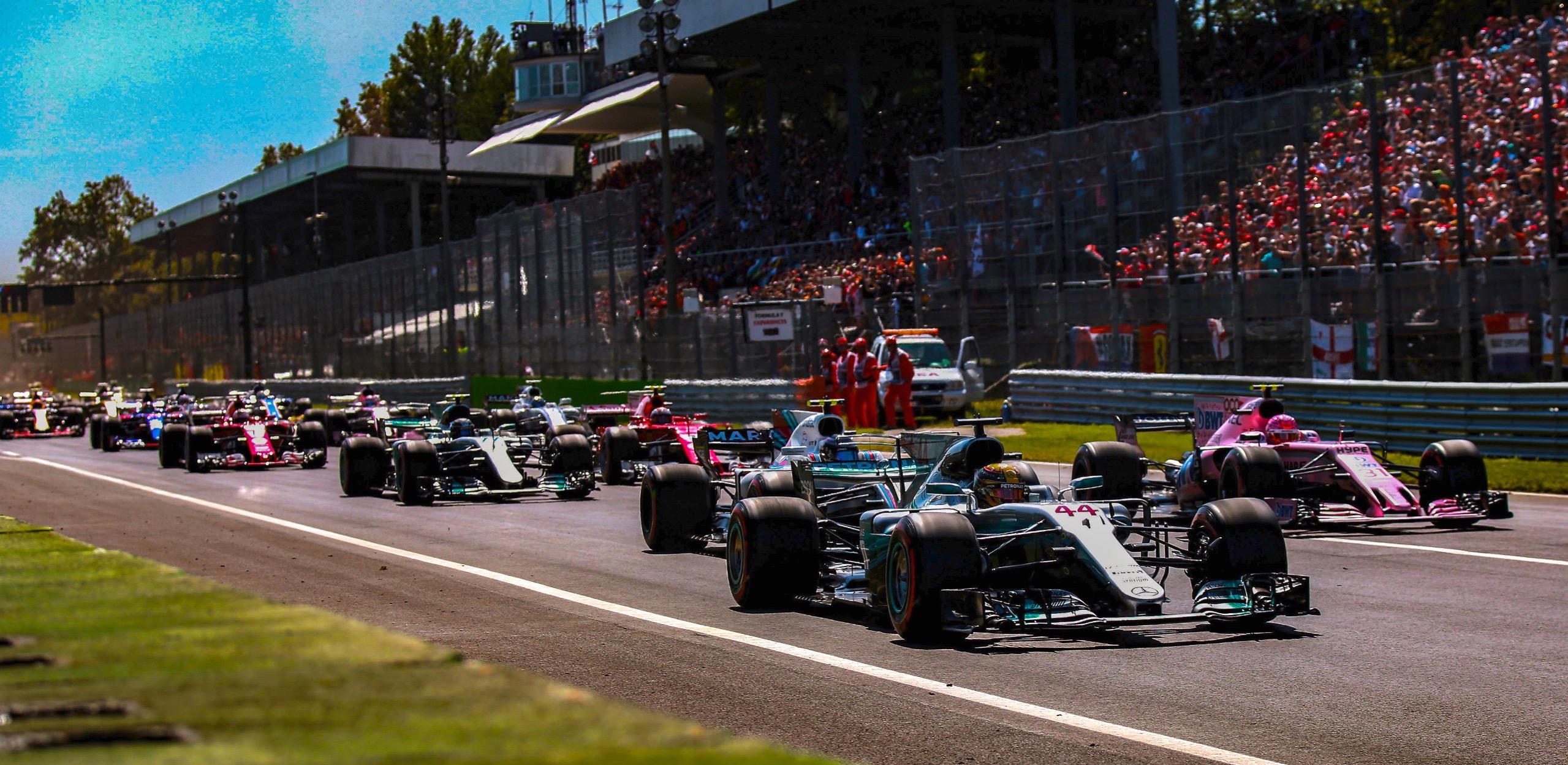
Lewis Hamilton had a weekend that few drivers have even dared to dream. First the all-time qualifying record, then utter domination in the fastest car of the turbo era winning his 59th career victory on the fastest track making him the first back-to-back winner of the 2017 season while also giving him two commanding victories in seven days. And done with such ease that everything else seemed very dull.

Hamilton is also the first Englishman to win four times at Monza, beating Stirling Moss who won in Italy in 1956, 1957 and 1959. Add on a historic 69th pole this weekend, and he is a class of one at this time and remains Formula 1’s benchmark driver – just like Moss in his day.
Four-time World Champion Sebastian Vettel has never lost a world championship that he has led. The European season just ending featured the last two high-downforce and power-hungry circuits on the calendar. As the F1 circus goes forward, the remaining races, at primarily Tilke-designed circuits favour all-around balance rather than just speed and grunt. Vettel will be expecting to retake points from Hamilton at Singapore’s “Maze of a Thousand Turns” in two weeks. From there, Asia and the Americas will decide if Vettel’s championship-keeping record stays intact.
Now it’s on to Singapore’s Marina Bay Street Circuit in two weeks.
